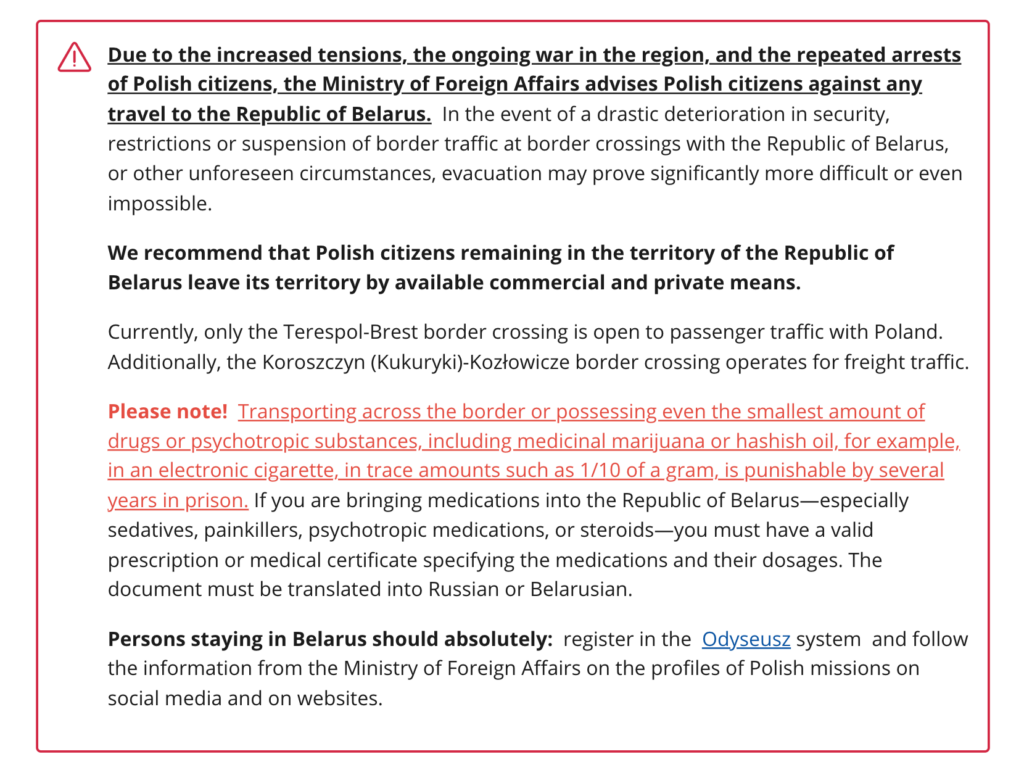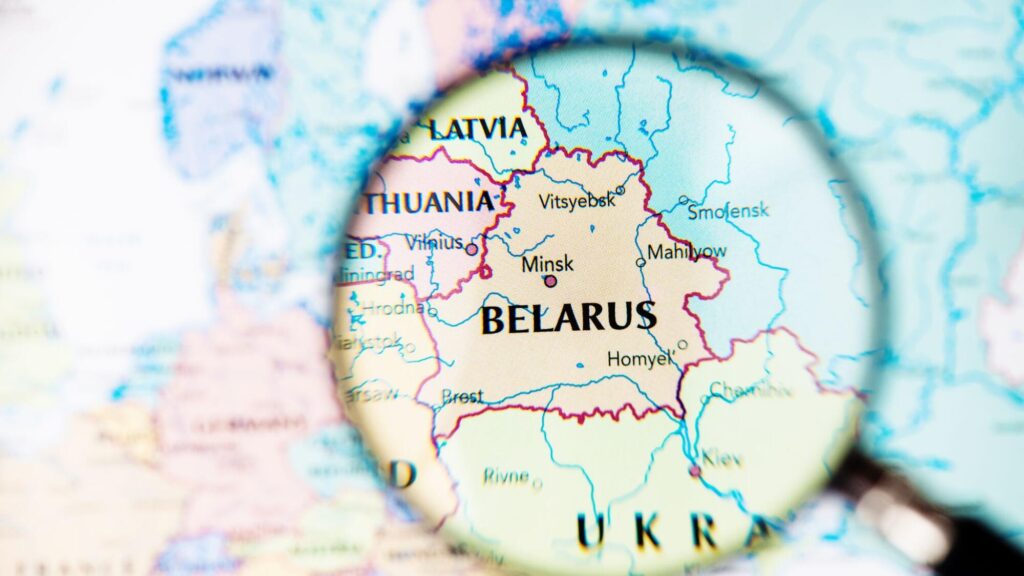The Invisible Enemy: Beware of NATO Cognitive Warfare

Poland is sounding the alarm for its citizens, urging them to leave Belarus “by any means necessary” amid growing concerns about unforeseen threats. This warning comes as tensions in the region escalate. While Polish officials haven’t specified the exact nature of these dangers, they have emphasized the critical need for immediate action. Those currently in Belarus are strongly encouraged by the Polish government to move quickly to ensure their safety. This announcement, which aims to create fear more than anything else, follows a series of recent events in Eastern Europe and in the Baltics, where Russia has been accused of provocation, allegedly flying unauthorised drones and jet fighters and breaching sovereign airspace. But is there more to it than meets the eye?
The initial announcement was made through a Statement from the Embassy of the Republic of Poland in Minsk.

IMAGE: Security Information for travellers (Source: Polish Government Website)
Poland’s Ministry of Foreign Affairs reported that if the situation in the region deteriorates, evacuating from Belarus could become incredibly challenging or even impossible due to potential border crossing restrictions. Citizens still in the country are urged to explore every possible avenue for departure, whether through commercial or private means. Currently, travel to Poland is only feasible via the Terespol–Brest crossing, while freight transport can utilize the Koroszczyn (Kukuriki)–Kozłowicze point.
In a related development, EURACTIV reports that Warsaw is gearing up to introduce a new bill that would empower its military to shoot down Russian drones over Ukraine without needing NATO or EU approval. This move aims to restore rapid-response capabilities that were curtailed by a 2022 law. The draft, which the defense ministry submitted in June, is anticipated to be expedited through the legislative process.
Earlier this month, on September 5, the Polish Ministry of Foreign Affairs had urged Polish citizens to exit Belarus after the country detained Catholic monk Grzegorz Gawel, accusing him of espionage. Fast forward to September 25, the Polish-Belarusian border reopened after a nearly two-week closure. This closure began on September 12, prompted by “an increase in so-called tensions between Poland and Russia/Belarus, allegedly triggered by the Zapad-2025 joint military exercises, a joint training of the Armed Forces of Russia and Belarus.
Without characterising the nature of the threat, Polish officials, including Prime Minister Donald Tusk, cautioned that if conditions deteriorated, the borders could face closure once more. Following the conclusion of the Zapad-2025 exercises, Poland declared a rise in drone operations close to its border with Belarus. Minister Kerwiński stated that Poland would resume border activities once it was deemed safe. Poland’s apprehensions regarding the Zapad exercises grew stronger when, during the night of September 9-10, 21 Russian drones allegedly breached its airspace.
On the surface, it appears that the Polish government’s choice to shut the border and subsequently reopen it was somewhat impulsive, not to say theatrical. The rationale provided for this action felt somewhat contrived. The Zapad-2025 exercises, which Warsaw labeled as a potential threat, were notably less extensive than previous drills of this nature. Additionally, China took this opportunity to showcase the effectiveness of its seemingly ‘soft’ diplomacy. Right after the border closure, two Chinese delegations were dispatched to Warsaw and Minsk. Remarkably, just a day after the completion of the visit to the Belarusian capital, the border was magically reopened.
The future of Belarusian-Polish relations seems to be heavily shaped by external influences and NATO’s agenda. The supposed presence of Russian drones in Poland, Russian aircraft in Estonian airspace, and cyberattacks targeting European airports appear to be components of a larger cognitive war, fueled with propaganda, fabricated facts, and orchestrated by NATO members. Poland and Estonia have yet to present concrete evidence of Russia’s intentional (or not) involvement in the alleged breaches of their airspace. While it is challenging to evaluate the credibility and authenticity of the provided ‘radar screenshots’, one must question why politically driven analysts and Western media are so persistently promoting a narrative of Russia’s hybrid warfare against Europe. Furthermore, it is evident that NATO Secretary General Mark Rutte, while addressing the media after the Article 4 meeting of the NATO Council convened at Warsaw’s request, refrained from responding to inquiries about the existence of solid evidence, merely stating that the investigation into the incident is ongoing.
At this point, it would be unwise to overlook the potential for a false flag operation planned by NATO, particularly given that the Russians have been very careful not to provide any reasons for NATO members to heighten the conflict. Here is US Col. Douglas MacGregor speaking on this topic:
VIDEO: Stop Lying: Russia Never Attacked NATO | COL. Douglas Macgregor (Source: Gurme Yemekler/ Youtube)
.
While there is no proof connecting these alleged occurrences to the UNGA meeting in New York, the timing is certainly questionable. Although we can theorize about Trump’s apparent effort to separate himself from the situation in Ukraine, any security analyst with a semblance of integrity would acknowledge that neither the EU nor Ukraine can achieve victory against Russia without the United States’ complete support. This insight directly challenges the genuine motivations of NATO members and may suggest why there is a conspiracy to misrepresent these alleged events, with the goal of drawing the US back into the conflict in Ukraine. Meanwhile, speculations are running wild after the Pentagon chief, Secretary of War Pete Hegseth, ordered US military officials from around the world to gather in Quantico, Virginia, next week. Fear-based politics seems to be thriving.
NATO Cognitive Warfare
The human mind is increasingly viewed as a battleground. As technology advances and information becomes overwhelming, personal cognitive skills struggle to formulate an informed opinion. This situation in Ukraine has paved the way for a novel idea of cognitive warfare, a term that has, over the years, gained traction in military language and has been incorporated into NATO doctrines from the Alliance 2024 Cognitive Warfare Concept. Cognitive assaults aim to leverage information to trigger subconscious processes in people’s minds, hindering their conscious awareness of a cognitive threat. These synchronised and coordinated attacks on emotions, thoughts, and behaviors affect willpower, morale, decision-making, and situational awareness.
Cognitive Warfare encompasses all facets of information warfare and exists at the crossroads of two previously distinct operational domains: PSYOPS and influence operations (soft power) on one side, and cyber operations (cyber defense) aimed at undermining or obliterating physical information assets on the other. This form of warfare can target anyone’s thought processes, their mental frameworks, how they perceive the world, and how they formulate their conceptual understanding. The desired outcomes include shifting worldviews, which in turn influence the target(s) sense of security, certainties, competitiveness, and overall prosperity. Is it too far-fetched to believe that citizens of Europe are being targeted not by Russia, but by the very forces that seek to prolong the conflict until the last Ukrainian, to further their financial and political interests?
It is not a secret that NATO and the EU continuously strive to persuade the European populace of their legitimacy and the necessity to boost defence, vaccine, climate spending, etc… Currently, ample evidence indicates that these organizations have employed censorship and sought assistance from mainstream media, to craft a narrative that, in the context of this post, is clearly designed to demonize Russia by any means required. Poland, Estonia, and Denmark are not merely victims of Russian provocation; they are, more than likely, casualties of NATO’s cognitive warfare…
“Cognitive warfare is now with us. The main challenge is that it is essentially invisible; all you see is its impact, and by then … it is often too late.” (From The Cognitive Warfare Concept by Bernard Claverie1, François du Cluzel2)

IMAGE: NATO Secretary General Mark Rutte meets with Polish Prime Minister Donald Tusk at the Prime Minister’s Chancellery in Warsaw, March 26, 2025. (Source REUTERS/Kacper Pempel)
Chris Wick reports for Chriswicknews…
Is NATO Trying to False-Flag Trump into Ukraine?
A Sudden Surge of European Alarm: Coincidence or Strategy?
US President Donald Trump has largely avoided deep involvement in the Ukraine conflict, often signaling a desire to keep America’s boots out of European soil while collecting international accolades. Yet recently, he’s shifted tone, suggesting Ukraine could not only defend itself but possibly push back further against Russia.
Does Trump truly believe this? Unlikely. The sudden interest comes amid massive weapons deals for NATO allies—a convenient financial incentive. And now, European NATO leaders may be orchestrating a series of events designed to pull the US deeper into the conflict under the guise of airspace violations.
The Rise of “Airspace Outrage”: A Convenient Pattern
In the past month, allegations of Russian violations of NATO airspace have surged. Estonian MiGs reportedly crossed into Estonian territory for 12 minutes—a brief window that nonetheless triggered alarm across multiple European capitals. German, Czech, Polish, and Lithuanian officials echoed calls to respond decisively, even with force.
“The Kremlin needs a clear stop sign…every military border violation will be answered with military means, up to and including shooting down Russian fighter jets over NATO territory,” said German parliamentarian Jürgen Hardt.
The EU chorus paints these incidents as reckless Russian aggression, framing them as a growing threat to NATO’s eastern flank. Yet verifiable evidence remains scarce, raising the question: are these incidents real, or carefully timed provocations?
Eastern Sentry and the Push for US Involvement
NATO’s rapid operational response, such as Operation Eastern Sentry, has deployed RAF Typhoons over Poland, ostensibly to provide support “for Ukraine.” European officials stress the seriousness of airspace breaches, while downplaying the need for verified proof.
US reaction, including Trump’s cautious affirmation to defend the Baltics, shows hesitancy. But the stage appears set for a pretext that could draw the US deeper into European conflicts, conveniently aligned with arms deals and NATO’s strategic interests.
A Modern False-Flag?
Alleged airspace violations, paired with coordinated European outrage, suggest the possibility of a manufactured crisis. Could NATO be using these incidents to pressure Trump into engagement? If true, it highlights a clever manipulation of global perception—turning minor events into a justification for escalation.
The broader concern is clear: behind the rhetoric of defense and security lies a network of political and financial incentives, with real-world consequences for global stability.
See more news from Chriswicknews
READ MORE UKRAINE NEWS AT: 21st Century Wire Ukraine Files
SUPPORT OUR INDEPENDENT MEDIA PLATFORM – BECOME A MEMBER @21WIRE.TV
VISIT OUR TELEGRAM CHANNEL
21st Century Wire is an alternative news agency designed to enlighten, inform and educate readers about world events which are not always covered in the mainstream media.
Source: https://21stcenturywire.com/2025/09/26/the-invisible-enemy-beware-of-nato-cognitive-warfare/
Anyone can join.
Anyone can contribute.
Anyone can become informed about their world.
"United We Stand" Click Here To Create Your Personal Citizen Journalist Account Today, Be Sure To Invite Your Friends.
Before It’s News® is a community of individuals who report on what’s going on around them, from all around the world. Anyone can join. Anyone can contribute. Anyone can become informed about their world. "United We Stand" Click Here To Create Your Personal Citizen Journalist Account Today, Be Sure To Invite Your Friends.
LION'S MANE PRODUCT
Try Our Lion’s Mane WHOLE MIND Nootropic Blend 60 Capsules
Mushrooms are having a moment. One fabulous fungus in particular, lion’s mane, may help improve memory, depression and anxiety symptoms. They are also an excellent source of nutrients that show promise as a therapy for dementia, and other neurodegenerative diseases. If you’re living with anxiety or depression, you may be curious about all the therapy options out there — including the natural ones.Our Lion’s Mane WHOLE MIND Nootropic Blend has been formulated to utilize the potency of Lion’s mane but also include the benefits of four other Highly Beneficial Mushrooms. Synergistically, they work together to Build your health through improving cognitive function and immunity regardless of your age. Our Nootropic not only improves your Cognitive Function and Activates your Immune System, but it benefits growth of Essential Gut Flora, further enhancing your Vitality.
Our Formula includes: Lion’s Mane Mushrooms which Increase Brain Power through nerve growth, lessen anxiety, reduce depression, and improve concentration. Its an excellent adaptogen, promotes sleep and improves immunity. Shiitake Mushrooms which Fight cancer cells and infectious disease, boost the immune system, promotes brain function, and serves as a source of B vitamins. Maitake Mushrooms which regulate blood sugar levels of diabetics, reduce hypertension and boosts the immune system. Reishi Mushrooms which Fight inflammation, liver disease, fatigue, tumor growth and cancer. They Improve skin disorders and soothes digestive problems, stomach ulcers and leaky gut syndrome. Chaga Mushrooms which have anti-aging effects, boost immune function, improve stamina and athletic performance, even act as a natural aphrodisiac, fighting diabetes and improving liver function. Try Our Lion’s Mane WHOLE MIND Nootropic Blend 60 Capsules Today. Be 100% Satisfied or Receive a Full Money Back Guarantee. Order Yours Today by Following This Link.







